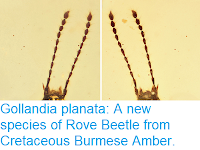Frogs, Anura, first appeared over 200 million years ago, and are a highly successful group today with over 6900 described species. However, despite the antiquity of the group, they have a relatively poor fossil record, making it difficult to understand the evolutionary history of the group. Crown group Frogs (everything descended from the last common ancestor of all living Frogs) probably appeared some time in the Mesozoic, but living Frogs are divided into several distinct groups, most of which are thought to have originated shortly after the End Cretaceous Extinction. Modern Frogs reach their maximum diversity in tropical rainforests, but it is unclear how old this relationship is, due to the relative modernity of extant Frog groups, and the paucity of Frog fossils from these habitats, as most Mesozoic Frog fossils come from either temperate or dry environments.
In a paper published in the journal Scientific Reports on 14 June 2018, Lida Xing of the State Key Laboratory of Biogeology and Environmental Geology and the School of the Earth Sciences and Resources at the China University of Geosciences, Edward Stanley of the Florida Museum of Natural History at the University of Florida, Ming Bai of the Key Laboratory of Zoological Systematics and Evolution at the Institute of Zoology of the Chinese Academy of Sciences, and David Blackburn, also of the Florida Museum of Natural History, describe a new species of Frog from Cretaceous Burmese Amber.
Cretaceous ‘Burmese Amber’ has been extensively worked at several sites across northern Myanmar (though mostly in Kachin State) in the last 20 years. The amber is fairly clear, and often found in large chunks, providing an exceptional window into the Middle Cretaceous Insect fauna. This amber is thought to have started out as the resin of a Coniferous Tree, possibly a Cypress or an Araucaria, growing in a moist tropical forest. This amber has been dated to between 105 and 95 million years old, based upon pollen inclusions, and to about 98.8 million years by uranium/lead dating of ash inclusions in the amber.
The Frog is placed in a new genus and species, Electrorana limoae, where ‘Electrorana’ means ‘Amber Frog’ and ‘limoae’ honours Mrs. Mo Li, who purchased the specimens in the Angbamo area of Kachin Province, northern Myanmar in August 2015, and donated them to the Dexu Institute of Palaeontology. The species is described from four specimens, including one partial skeleton, two partial forelimbs and the general body shape of a frog that x-ray computed tomography reveals contains no skeletal material within.
Cretaceous ‘Burmese Amber’ has been extensively worked at several sites across northern Myanmar (though mostly in Kachin State) in the last 20 years. The amber is fairly clear, and often found in large chunks, providing an exceptional window into the Middle Cretaceous Insect fauna. This amber is thought to have started out as the resin of a Coniferous Tree, possibly a Cypress or an Araucaria, growing in a moist tropical forest. This amber has been dated to between 105 and 95 million years old, based upon pollen inclusions, and to about 98.8 million years by uranium/lead dating of ash inclusions in the amber.
The Frog is placed in a new genus and species, Electrorana limoae, where ‘Electrorana’ means ‘Amber Frog’ and ‘limoae’ honours Mrs. Mo Li, who purchased the specimens in the Angbamo area of Kachin Province, northern Myanmar in August 2015, and donated them to the Dexu Institute of Palaeontology. The species is described from four specimens, including one partial skeleton, two partial forelimbs and the general body shape of a frog that x-ray computed tomography reveals contains no skeletal material within.
Photograph images of four fossil Frog specimens referred to Electrorana, including the holotype (A) and three additional specimens (B), (C), and (D). Specimenscin (B) and (D) are presented with two views of the amber specimen and the oval in (D) indicates the presence of the Anuran specimen. Scale bars equal 5 mm. Xing et al. (2018).
Previous inclusions described from Burmese Amber include Mosses and Bamboo-like Monocots, Pisaurid Spiders, Onycophorans, Dyspnoid Harvestman, and Coccoid Scale Insects, suggesting that the amber was produced by trees growing in a warm, moist environment, such as a tropical rainforest, providing the first direct evidence of Frogs colonising these environments.
(a) Electrorana limoae as visualized via microCT scanning. (b) Unidentified coleopteran embedded in amber with holotype. Skull in dorsal (c), left lateral (d), and ventral (e) views. Ventral views of pectoral girdle (f), left hand (g), vertebral column (h), and left foot (i). Abbreviations of anatomical terms are as follows: clav, clavicle; cor, coracoid; dent, dentary; exoc, exoccipital; fpar, frontoparietal; max, maxilla; phyd, parahyoid; pmax, premaxilla; postmed proc, posteromedial process of hyoid; pro, prootic; prsph, parasphenoid; pter, pterygoid; qj, quadratojugal; raduln, radioulna; scap, scapula; sept, septomaxilla; sq, squamosal; supscap, suprascapula; unc, uncinate process. The number of each digit is indicated with roman numerals. Scale bar for (c)–(e), 2 mm; scale bar for (b), (f)–(i) 1 mm. Xing et al. (2019).
See also...
Follow Sciency Thoughts on
Facebook.








